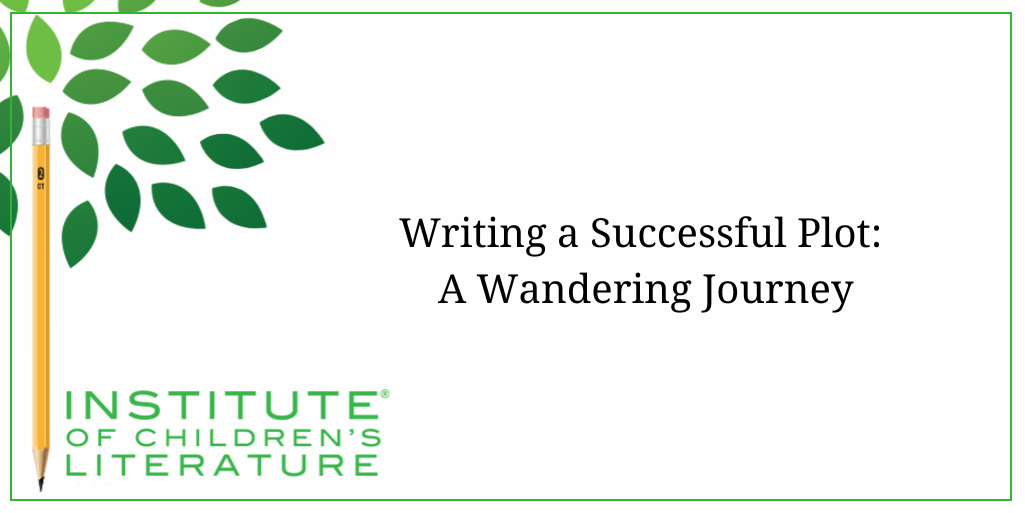
5 Ways Writers Can Prep for 2025 Goal Setting
Before we roll on to the new writing year, let’s harness our optimism for the blank slate before us and prepare for our 2025 Goal Setting just for writers.

How many times have we gotten information about distances from one place to another “as the crow flies.” This always means the shortest possible distance from one place to another, marked by a straight line. But real journeys don’t work that way. Even airplanes rarely travel from one place to another exactly as the crow flies. I remember being in a plane for an hour once, circling an airport while the pilot waited for an electrical storm to pass.

Plot is complicated and the complications that bump us out of the straight line are called conflict.
Normally, the word conflict calls up visions of arguing, maybe even fighting, with someone else over something. In plot, the word takes on a broader meaning. Conflict is really anything that disrupts that straight-line flight between the character having a need or want, and achieving resolution of that need or want. Let’s look at it as a kind of equation.
Your character needs something but something stands in the way of him getting it easily. That something is conflict, even when it isn’t any kind of squabble with another character. For example, a character may need the Magical Jewel of Emry in order to release his father from captivity by the evil King of Trolls. Now his father being in captivity is the problem. And the evil trolls are almost certainly going to be a source of conflict. They are the reason why the character doesn’t simply march over and throw open the cage that holds his father. We get this kind of conflict easily enough.
But we need more than the most basic bump in the road to make a good story. So let’s add more conflict when he learns that holding the Magical Jewel of Emry will allow him to approach the cage without being seen by the trolls, thus allowing him to release his father without a fight.

Conflicts can grow out of things that your main character wants to avoid. It can be based on fear and often is. In this case, the main character is afraid of the power of the Crone of the Swamps, but in a different story a character could be frozen by fear of embarrassment, or fear of rejection, or simply fear of failing.
Fear comes from within, but it can take many forms when used as a point of conflict for your story. Fear is a great inner conflict but it doesn’t have to be the only option. The character may act out of a strong dislike toward someone. He may choose not to do something because the action would make life better for an enemy. A character may even act out of love. He may refuse to do something that would save himself if it means hurting the person he loves. So possibilities abound in terms of inner conflict, and the best stories make use of these.
One of the reasons roads can’t usually lie in a straight line from one point to another is physical obstacles. Roads may veer around mountains or follow the torturous track of rivers (which are always irregular) or circle around a lake or simply swerve to avoid a crowded area that will slow traffic. None of these kinds of obstacles are doing anything intentionally to block the road. They create an obstacle simply by existing.
Story plots can make use of this kind of conflict too. A character may face the obstacle of a normally placid stream that has been swollen to dangerous levels by storms. Now the stream simply isn’t crossable by fording and the character must seek a different means of crossing. Or a character may face the dangers of bogs or be slowed down by the need to climb a cliff. None of these things are acting by intent. They simply exist and the character must deal with that in order to reach the destination.
Throwing these kinds of conflicts in a character’s path can give the story time to slow down while the character plans a new route. This slowing down time can allow for character growth, dialogue, and other useful techniques for deepening the story. And these kinds of conflicts without intent don’t need to be huge and dangerous. They can be as simple as the ending of a school day that keeps a character from having a chance to search the school for something or from speaking to another schoolmate in the classroom.
The detours demanded and the unexpected problems are important to a strong plot because they keep the story lively and prevent readers from finding the tale too predictable. Readers enjoy guessing what is going to happen next, but they also like it when they’re wrong and you give them a surprise. And this unpredictable route does more than add interest, it adds to the character’s motivation as well.

In this situation, without the core conflict of a fear of ghosts, the story could be really short. The character goes inside, grabs the item and comes out. That wouldn’t be overly interesting, even if it’s a really interesting setting, and your main character is a quirky, interesting person. You need those bumps and twists to keep the journey from being too short and too easy. By adding conflict and adding difficulty, you’re making the story feel more important as well as more interesting. Sometimes it takes a bit of brainstorming to come up with interesting and unexpected detours, but the end result will always be a more unique, unexpected story journey.
In this hypothetical situation, you might add dangerously decayed building structure and maybe a squatter in the house who doesn’t want to be discovered and booted out. To keep the main character from simply leaving when the going gets tougher than he expected, you may need to add to his motivation even as you’re adding problems. Your motivation must always meet your conflict if your story is to be believed. Maybe the main character has a huge stake in not being seen as chicken by this group of kids. Or maybe he only wants to be admired by one of them. Or maybe he is sent into the house with another kid along with him and the other kid disappears. The main character may feel he can’t leave alone.
Complex motivation meeting complex conflicts makes for the best story journey as you plot. Keep them both twisting and turning. However you get to the end, just be sure your route wasn’t as the crow flies and your story will be stronger for it.
With over 100 books in publication, Jan Fields writes both chapter books for children and mystery novels for adults. She’s also known for a variety of experiences teaching writing, from one session SCBWI events to lengthier Highlights Foundation workshops to these blog posts for the Institute of Children’s Literature. As a former ICL instructor, Jan enjoys equipping writers for success in whatever way she can.

Before we roll on to the new writing year, let’s harness our optimism for the blank slate before us and prepare for our 2025 Goal Setting just for writers.

Writers can be thin-skinned when it comes to getting feedback on their work. Let’s look at 4 ways to positively deal with constructive criticism!

Rejection is part of the territory when it comes to being a writer. Today we offer reflection for writers to help redirect your efforts after a rejection.
1000 N. West Street #1200, Wilmington, DE 19801
© 2024 Direct Learning Systems, Inc. All rights reserved.
1000 N. West Street #1200, Wilmington, DE 19801
© 2024 Direct Learning Systems, Inc. All rights reserved.
1000 N. West Street #1200, Wilmington, DE 19801
© 2024 Direct Learning Systems, Inc. All rights reserved.
1000 N. West Street #1200, Wilmington, DE 19801
© 2024 Direct Learning Systems, Inc. All rights reserved.

1000 N. West Street #1200, Wilmington, DE 19801
© 2025 Direct Learning Systems, Inc. All rights reserved.

1000 N. West Street #1200, Wilmington, DE 19801
©2025 Direct Learning Systems, Inc. All rights reserved. Privacy Policy.
2 Comments